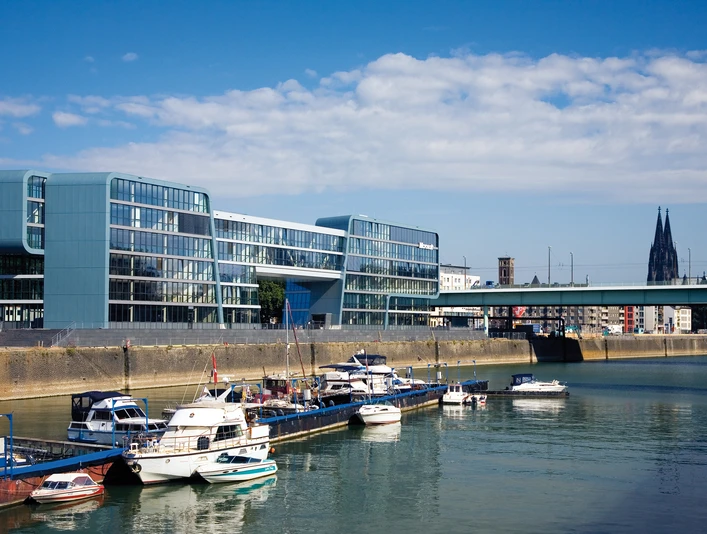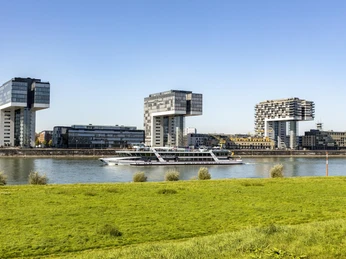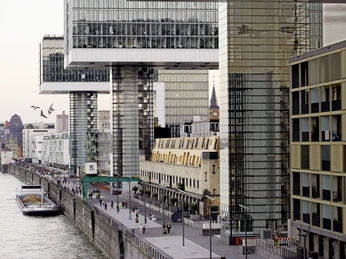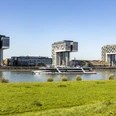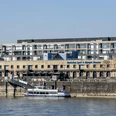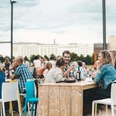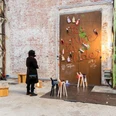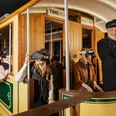A harbour panorama, a historical backdrop and modern architecture
Cologne also has an island, which was originally 720 metres long and 40 metres wide. Today you may no longer be able to recognize the Rheinauhafen as an island, because it doesn’t have a sandy beach or a coastline. The Werthchen, as the island was called, used to be a place for leisure activities and relaxation. It even had a restaurant. But the Werthchen was eventually widened and became the Rheinauhafen (Rheinau Harbour). Later it became Cologne’s showplace for state-of-the-art urban architecture.
When you enter the Rheinauhafen across the swing bridge — which was built in 1896 and is Cologne’s oldest bridge on the Rhine — you can still see that it used to be an island. Today it’s a promenade zone, thanks to its Crane Houses, the Chocolate Museum, the German Sport & Olympia Museum, cafés, restaurants, a skater park, historic buildings such as the harbour cranes, which are listed monuments, and a fortified tower dating back to the Middle Ages. Let’s take an imaginary stroll along the Harbour…
The Chocolate Museum: the world’s most comprehensive cocoa exhibition
You can experience the world of cocoa and chocolate close up in this special museum at the Rheinau Harbour. The entire spectrum of the history of cocoa, which has been cultivated for some 5,000 years, is on display here in a combination of new buildings and a renovated Prussian customs office from 1898.
In the Chocolate Museum you’re sure to be sweetly seduced by the chocolate fountain, a walk through the tropical greenhouse, and the “transparent” chocolate factory, as well as many exhibits and machines. The museum offers guided tours, exhibitions and tastings on 4,000 square metres of floor space, including its adjacent café.
The German Sport and Olympia Museum: a salute to sport
Here you can enjoy the world of sport, from the Olympic Games to World and European championships and the personal mementos of an athlete, exemplified in approximately 2,000 exhibits. The historic museum building was originally a warehouse built in 1898. In 1999 the German Sports & Olympics Museum opened its doors here as an exhibition space for the history of sport from ancient times to the present day. From exhibits to a hands-on activity area: about 150,000 visitors per year enjoy the impressions of sport history they experience at the museum. The museum has spectacular sports fields on the roof, where it’s possible to play football, tennis or basketball.
The Crane Houses: shaping the skyline
The real eye-catchers at the Rheinau Harbour are the Crane Houses — three residential and office buildings designed to look like harbour cranes. They are visually impressive because of their unusual architecture: a two-part cantilever arm juts out at a height of 40 metres from a slender, fully glassed-in stair tower. The Crane Houses offer approximately 53,000 square metres of floor space in total. In the middle Crane House is a Michelin-star restaurant, the Ox & Klee.
The Bayenturm: a medieval tower amidst modernity
In the midst of this hypermodern atmosphere, the Bayenturm (Bayen Tower) rises up like a stalwart piece of Cologne’s medieval history. It was built around 1220 and was part of the original city wall that surrounded Cologne. For many centuries, it was regarded as the city’s hallmark. It was badly damaged during World War II and not renovated until the 1990s. Today the Bayenturm houses the FrauenMediaTurm (Women’s Media Tower), an archive of feminist media with a library.
Silo 23: an impressive sight
The unusually shaped roof of the Silo 23 building adds a striking note to the typical silhouette of the Rheinauhafen. It was originally built as a grain silo in 1940, but today it’s an office building with 3,800 square metres of rental space.
This Siebengebirge has nine roofs
The renovation and restructuring of the Siebengebirge residential complex was completed in 2006. Until 1990 it served as a storage facility for Germany’s emergency reserves of wheat, and before that as warehouses for grain and general cargo. The building complex, which was formerly known as the Danziger Lagerhaus, is more than 177 metres long. Its current name, which means “Seven Hills”, is due to its transverse gables.
The Hercules crane: one of six preserved harbour cranes
At the end of the Rheinau Harbour you’ll see one of the six harbour cranes that have still been preserved. Originally there were more than 35 cranes in the harbour. The Hercules crane, whose name is due to its maximum lifting capacity of 30,000 kilogrammes, was built in 1897 and is now a listed historical monument. In 1924 it lifted the Dicker Pitter (Fat Peter) — Saint Peter’s Bell, which weighs 24,000 kilogrammes — from the train on the bell’s journey to its place in a steeple of Cologne Cathedral. You can take a look at the bell as you climb to the top of the Cathedral.
Skate Plaza: a popular hangout for skaters
The Kap686 Skate Plaza, an illuminated 2,000-square-metre park for skateboarders, is also a unique facility in Germany. Many national and international competitions and events for professional skateboard teams have been held here. Built with modern street-skating in mind, the park offers China banks, curbs, parallel manual pads, low-2-highs and beer banks from Barcelona. It’s located near the Südbrücke (South Bridge) at the Rhine kilometre mark 686 — hence its name.
Europe’s longest underground car park: state-of-the-art parking
This underground car park really does have room for every driver who’s looking for a parking space. It’s 1.6 kilometres long, has 41,000 square metres of floor space and can accommodate 1,400 vehicles. The garage, which was opened in November 2003, is not only the longest in Europe but also the second-longest in the world. It’s also considered to be Cologne’s best car park.
Microsoft Deutschland: in an attractive location
The software giant Microsoft also appreciates its prestigious location at the Rheinauhafen, where the world-renowned company has its headquarters for the German state of North Rhine-Westphalia in a striking building that occupies 10,400 square metres of floor space.
The history of the Rheinauhafen as a working harbour
After the plans for building a harbour had been completed, the Werthchen was widened and provided with bank reinforcements. After that, the island could accommodate warehouses, harbour cranes and rail tracks as well as a port and customs office. The Rheinauhafen was opened in 1898. In 1951, it was still the most important of Cologne’s four working harbours. Cruise ships from the Köln-Düsseldorfer KG company were still anchoring here in 1970, but at a certain point the port entrance became too narrow for modern ships and the harbour became a marina for yachts and small boats. After the years of redevelopment and refurbishment, the Rheinauhafen was reopened in its present-day form in 2014.
Good to know
Eligibility
for Groups
for families
for individual guests
Payment methods
Directions & Parking facilities
Directions by car: Enter "Rheinauhafen 50678 Köln" in your navigation device.
Public parking spaces are available in the "Parkhaus Rheinauhafen/Harry-Blum-Platz 2".
If the weather is nice, you can take a walk to the Rheinauhafen (approx. 2 km). Simply head south from the main train station along the Rheinuferpromenade.
Our recommendations
Nearby
